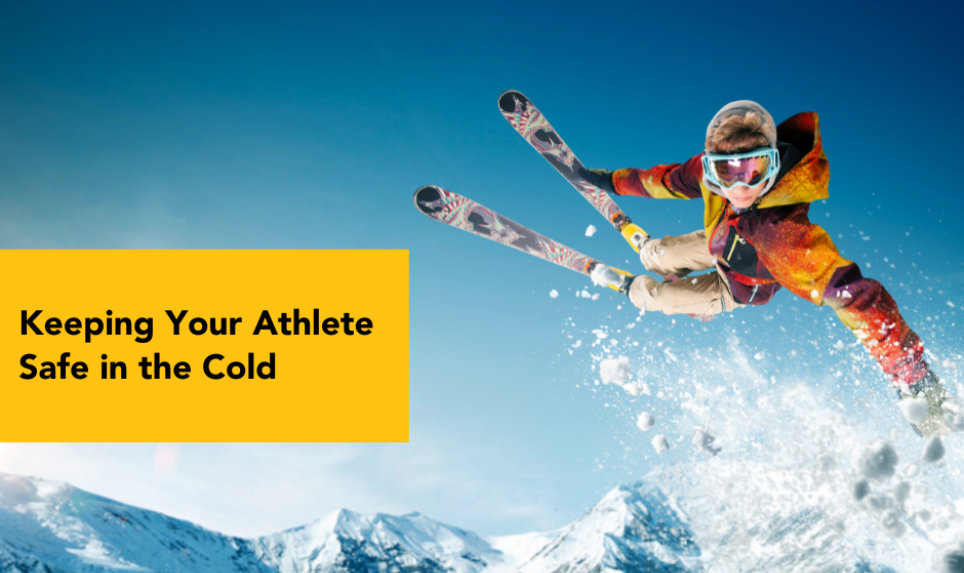This winter season is predicted to be “bone-chilling cold and loads of snow” for half of the country, from the East Coast to the Rockies, according to The 2023 Old Farmer’s Almanac. And while the other half is predicted to be wet and mild, don’t let your athletes be fooled … cold injuries can still occur, especially for sports that require snow and ice.
Parents may try to bundle up their student athlete like the kid from “A Christmas Story” but be warned - it’s one of the many myths of practicing or playing in the cold that could lead to injury. Cold injuries occur in a wide range of physically active individuals, including military personnel, traditional winter-sport athletes, and outdoor-sport athletes. Certified athletic trainers keep athletes safe by preventing and recognizing signs of weather-related injury then treating athletes quickly with life-saving techniques.
So what are these myths?
Myth #1 – The heavier the clothing, the better.
“People think you have to layer up a lot but that just restricts motion,” said Lynne Young, ME, ATC and director of athletic training for Orthopedic Physicians Alaska. “I always look back at the kid from ‘A Christmas Story’ and the little kid can’t move. Your muscles can’t get warm when you restrict motion.”
The National Athletic Trainers’ Association (NATA) recommends athletes keep safe by wearing insulated clothing that also allows moisture to evaporate as well as to dress in layers that can be removed with changes in the weather. Avoid cotton, which absorbs moisture and traps it next to your skin.
“Also make sure you keep digits warm with shoes and gloves and make sure your head is covered,” said Young, who treats many skiers and snowboarders. “We recommend that they wear a light face covering to help warm up (the cold air) before it gets to their lungs.”
Myth #2 – It’s cold out; there’s no need to drink water.
Some athletes practicing or playing in the cold think that because they aren’t perspiring, they don’t need to hydrate. But that couldn’t be further from the truth. When there isn’t enough fluid in the body, core temperatures can drop to dangerous levels and hypothermia can set in much quicker.
“Being properly hydrated helps keep the body warm,” said Michael Szymanski, MS, LAT, ATC, and director of education at the Korey Stringer Institute. “There is more plasma volume, which maintains adequate blood flow for circulation. Caffeine and alcohol should also be avoided prior to exposing yourself to the cold. Alcohol causes blood vessels to dilate, which causes heat loss. Caffeine restricts blood flow in the hands and feet which can increase your risk for a cold injury.”
Myth #3 – If you get signs of frostnip, rub the area.
Frostnip is the mildest form of cold injury to the skin and a precursor to frostbite, according to the 2008 National Athletic Trainers' Association Position Statement: Environmental Cold Injuries.
It can occur with exposure of the skin to very cold temperatures, often in combination with windy conditions. With frostnip, only the superficial skin is frozen; the tissues are not permanently damaged, although they may be more sensitive to cold.
“Best thing to do is not rub the area. If you massage the area, it’s going to cause more damage,” Szymanski said. “If it’s your fingertips put them under your arm pits. Gradually warm them. Key things about cold injuries are that the rewarming needs to occur gradually. It needs to be a slow process.”
Other Tips on Keeping Safe this Winter
Szymanski recalled his younger days practicing lacrosse in Virginia. “We had 6 a.m. practices in January; it snowed every day we were out there. It was ungodly cold. I kept myself moving. As our muscles contract they produce heat so it warms up the body. If I knew I would be standing in line for a while I would do some pushups and jog in place - anything I could do to keep myself warm.”
Other recommendations include:
• Take regular indoor breaks.
• Maintain a well-balanced diet.
• Have extra shoes, socks and gloves available to replace wet clothing.
For more information on cold injuries and how to prevent them, download our Cold Injury Handout.
